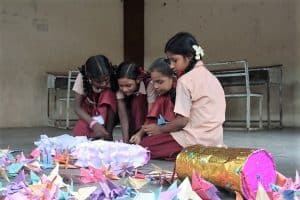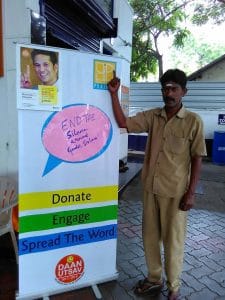“And through this having and giving and sharing and receiving, we too can share and love and have… and receive.”– Joey Tribbiani, in “Friends”.
Funny that this quote, part of Joey’s intended speech at the wedding of his friends Monica and Chandler, would be apt for a nationwide festival of giving! Daan Utsav is not just about the receiving, we know, it is about the giving. A festival that turns the lens on to itself, like a particularly gorgeous selfie.
When I began volunteering for Daan Utsav, I had not seen it up close. I had read about it in the papers, and to me, it all seemed a little too Valentines’ Day-ish. How wrong I was!
Volunteering for Daan Utsav was magical in many ways: it taught me more lessons on life and giving than any moral science class in all my years of schooling and college did. As we roamed the streets of Chennai looking for night conservancy workers for Sumita Pai’s amazing #SareesbyNight initiative, the true meaning of giving hit home, as one woman ensured all her colleagues received the gift package, before reaching out for hers.
Primary and middle-schoolers at a government school were making paper cranes—a thousand of them—praying for the good health of the chief minister. One of them, about ten, said she did not know what everyone else was praying for, but she wanted to study well in school. “And I want my friend Dhanalakshmi also to study well. That’s what I prayed for,” she said, as her friend tied the paper cranes on a metal grill.
IOC had opened up its fuelling stations for NGOs to put up their stalls and activity booths, where they could raise funds for their cause. In more than one place, the owners (and employees) of the petrol bunks chipped in generously, donating and encouraging others to donate as well.
At Koyambedu, fruit and vegetable vendors donated their produce without a second thought. Their generosity was only limited by the capacity of the transport van that the non-profits had brought along, as the van overflowed with fresh vegetables.
People signed up to paint railway stations in the colours of their imagination, to create happy places, at the MuRail Project.
As people young and old, rich and poor, male and female, gave in various forms – money, effort, resources, information, and anything they felt another person needed – giving became centrestage for a whole week. It was a glorious sight, a greater celebration than any other festival of the year.
The preparation for the festival is intense as well. Explaining the festival to organizations and communities, and convincing them that we were mere evangelists who believed in the festival, was a feat in itself. As other volunteers fielded questions about the festival with ease, I realized I had a lot to learn.
Sample these:
Can I just write out a cheque to Daan Utsav?
No, just like Diwali does not have an account, there is no bank account for Daan Utsav. We can refer you to NGOs if you’d like.
Why have a week for giving? We give throughout the year.
We have days simply to commemorate something. Why have an Independence Day? We are free every day of the year.
Who runs Daan Utsav?
No one. We are simply volunteers who believe that giving must be celebrated.
I don’t think I have the money for this right now.
You really don’t need any money. Children from corporation schools in Chennai made beautiful Thank You cards for the police and public health centre staff, for instance. Employees of companies cleaned streets. People stood at traffic signals encouraging people to wear their seat belts. None of these activities cost anything.
Some of these meetings were fruitful, some not. Some just needed more time than our small team could afford.
For me, the most magical moments were not during the festival, but the weeks leading up to it, when people tuned into the Daan Utsav frequency. When we met heads of organizations to explore ways in which they could celebrate the festival, sometimes, we could almost see the gears of their mind turning, and hear the ‘click’ as they ‘got’ the festival. Then, it was a sight to behold, as we knew that they would celebrate the festival; that giving would happen no matter where they were, and that they would ensure that many more people celebrated it also. That feeling, of having helped them tune in, was in itself extremely rewarding.
Now that Daan Utsav has ended, there is a feeling of emptiness. But there is also amazement. For the festival proved the impossible—that energy—giving energy—can be created, multiplied and shared.

